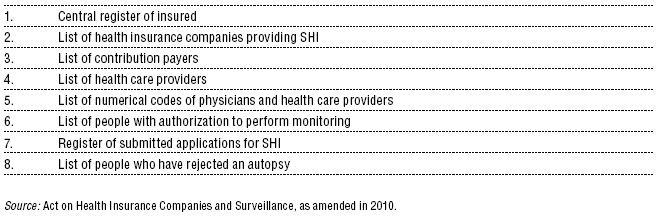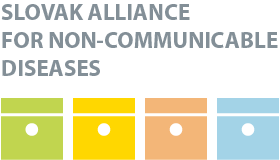—
HPI Network > HPI - Health Policy Institute > Health System in Slovakia > 2. Organization and governance > 2.7 Health information management
2.7 Health information management
Wednesday, 04. May 2011, 22:24 — HPI
| << PREVIOUS
2.6 Intersectorality |
Introduction – Organization – Financing – Resources – Provision – Reforms – Assessment – Conclusions – Appendices |
NEXT >>
2.8 Regulation |
Slovakia lacks a clear health information policy and, as a consequence, good quality information. This means that assessment of medical treatments is inadequate. The situation in drug policy has been improving. After securing access to current data on drug prices in other countries, a reference pricing system, with groups based on the lowest prices in Europe, has been introduced.
The collection of information on quality, performance of health care providers and health needs of the population leaves much to be desired in terms of management, structure and quality of data. The e-health project is mainly focused on the technical structure rather than content and functionality from the point of view of health policy decision-makers. Information on health insurance performance collected by the HCSA is more relevant and more accessible, but is only used by the HCSA to a small extent.
As a result of selective contracting and their purchasing role, health insurance companies play a key role in the planning process. By monitoring their financial flows, it is easy to collect relevant data. However, since there is no framework for quality benchmarking, health insurance companies are forced to perform their own analyses and surveys. In 2008, three health insurance companies were using information from patient satisfaction surveys for selective contracting.
2.7.1 Health technology assessment
There is no special state institution in charge of health technology assessment in Slovakia. The assessment of both novel and existing technologies is carried out through four independent “categorization” processes, which include: (1) categorization of pharmaceuticals; (2) categorization of medical devices; (3) categorization of dietary foods; and (4) categorization of diseases. For more information on the first two processes see sections 2.8.4 Regulation and governance of pharmaceuticals and 2.8.5 Regulation of medical devices and aids.
With regard to the categorization of diseases, the reform acts in 2004 created tools to define priority diseases, which have to be fully reimbursed, and the mechanisms for defining cost-sharing requirements or exclusion of non-priority diseases from the basic benefit package. However, these tools have not yet been used because this would be politically controversial. In practice, non-priority diseases are also covered without cost-sharing.
2.7.2 Information systems
Both government and independent analyses have declared that Slovakia is lagging behind in implementing health information technologies as compared to other countries in Europe and the world. Since the late 1990s, numerous plans, programmes and projects, including international cooperation in e-health, have remained at a theoretical level. However, in 2008, establishing a health information infrastructure was declared a health policy priority. The Ministry of Health estimated the expenses for building an e-health infrastructure at €250 million over a period of five years. The objectives of the e-health project will undergo a feasibility study and a proof of concept.
Information from various health sectors is collected by various actors using different methods. Lack of data interconnection imposes an administrative burden on all actors in the Slovak health system, particularly on health care providers. The collected data are not verified, with the exception of those where reporting is based on financial flows. Neither the indicators nor the standards of their reporting methodologies are available.
The law requires all health care providers (public and private), all health insurance companies (state-owned and privately owned), as well as self-governing regions, the PHA and legal entities under the management of the Ministry of Health to provide data in a systematic structure according to standards of the NCHI. In practice, this requirement is not fully met due to: (1) the non-existent unified information system; (2) the outdated data structure and standards; and (3) the fact that the NCHI does not have enough capacity to analyse the data. Hence, the reliability and validity of the data are poor and the data is often full of system errors. The data on health status, quality and performance of health care providers do not meet the needs of policy-makers to make informed decisions.
The NCHI collects information on the population’s health, and manages national health and administrative registers of patients and providers. The contents and the scope of the registers are outlined in law (Table 2.1). In accordance with new legislation, the NCHI has been collecting data related to e-health. It has also been developing a concept of a national health information system, including authorized electronic communication, electronic prescription, electronic patient records, reporting of medical procedures and systematic data collection.
Table 2.1: List of national administrative and health registers
| National administrative registers |
|
| National health registers |
|
Source: Act on Health Care, 2004 as amended in 2010.
Health care providers are reimbursed by health insurance companies according to certain reported indicators. However, the HCSA declared that the reported quality indicators are generally of low validity even though health insurance companies have used increased funding to stimulate effective data collection and electronic reporting. An obligation to report communicable diseases to the PHA applies to all health care providers.
Reporting of health insurance companies is more effective. The HCSA has access to the data of health insurance companies, which it analyses and publishes in annual reports. Information on waiting lists, a requirement since the 2004 reform, is not officially available despite the fact that maximum waiting lists are legally defined. Health insurance companies are responsible for the management of waiting lists. This lack of data makes HCSA monitoring more complicated and obstructs necessary feedback and information on the workings of the system to health policy-makers. The HCSA administers several registers and lists related to SHI (Table 2.2).
Table 2.2: Registers and lists in the HCSA

News
The amendment of the Decree on emergency medical service
Health insurance companies returned over 400 thousand €
The HCSA received 1,647 complaints last year
A half million people will earn more
Most of public limited companies ended in the black
Debt of hospitals on premiums has grown to nearly € 105 MM
Slovak health care may miss € 250 million next year
Profits of HIC amounted to € 69 mil. last year
Owners of Dôvera paid out money but did not paid taxes
Like us on Facebook!
Our analyses
- 10 Years of Health Care Reform
- New University Hospital in Bratislava
- Understanding informal patient payments in Kosovo’s healthcare system
- Analysis of waiting times 2013
- Health Policy Basic Frameworks 2014-2016
- Analysis of informal payments in the health sector in Slovakia
- Serbia: Brief health system review
developed by enscope, s.r.o.
